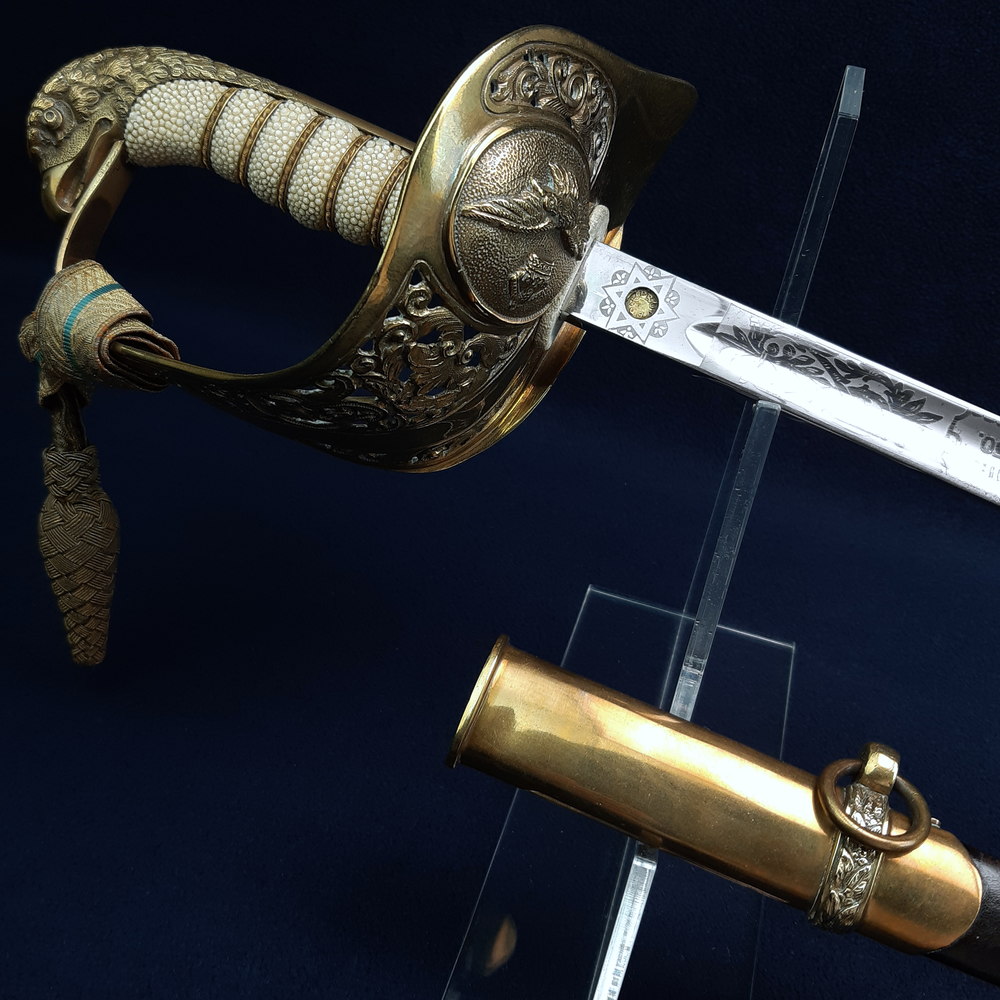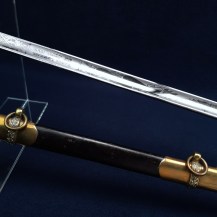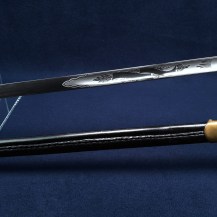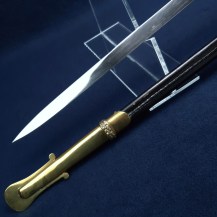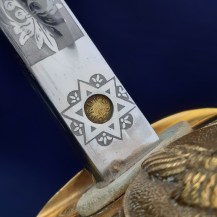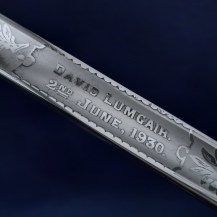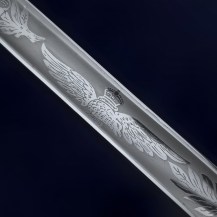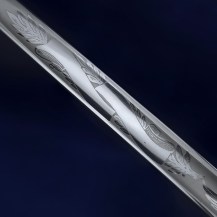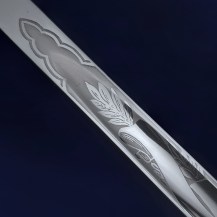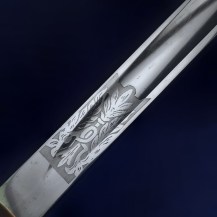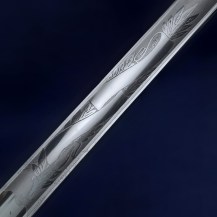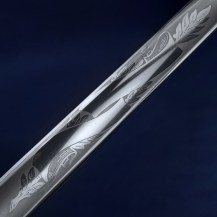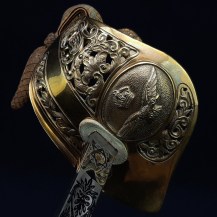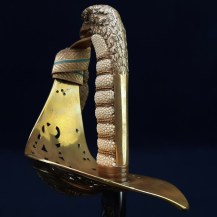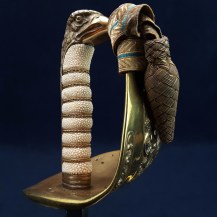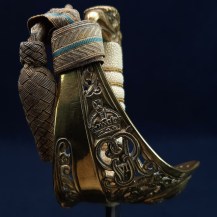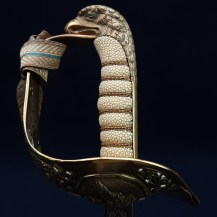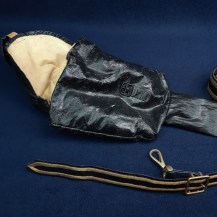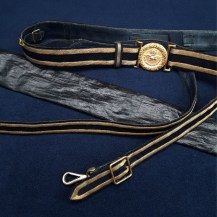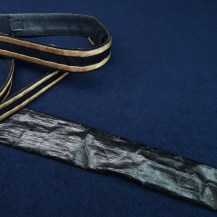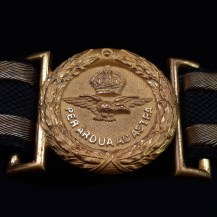British WW2 1925 Pattern Royal Air Force Officer's Sword of Group Captain David Lumgair CBE
Straight single-fullered spear-pointed blade. Brass hilt with pierced and cast decoration including the crown and cypher of King George VI and the crown & eagle badge of the Royal Air Force within an oval. Brass ferrule, brass backstrap, integral pommel in the form of an eagle’s head. Wire-bound white shagreen grip, white leather washer, blue and gold parade sword knot with acorn. Black leather scabbard with brass throat, chape and middle pieces, hanging rings on the throat and middle pieces. Black leather sword bag, blue and gold sword belt with brass buckle cast with the RAF badge and motto ‘PER ARDUA AD ASTRA’ within a laurel wreath. Blade 32 3/8 inches in length, the sword 38 inches overall.
The blade is etched at the ricasso on one side with a six-pointed star within which is set a brass proof slug stamped with ‘PROVED’ and a fleur de lys. The blade is further etched with banners and foliate motifs, centred around the royal coat of arms on one side, and the crown & eagle of the Royal Air Force on the other. There is a cartouche for the optional etching of the owner’s name, within which is etched ‘DAVID LUMGAIR 2ND JUNE 1930’.
George VI’s reign did not begin until 1936 and the etching does not appear to have been applied retrospectively, so it would seem that this sword was rehilted at some point in its owner’s career to bring the cypher up to date with the current monarch. This was not mandatory as previous cyphers were generally accepted on parade and could be seen as a mark of long service.
David Lumgair Jr was born in 1907 in Liscard, Cheshire, now a part of Wallasey. His family relocated from Cheshire to the Isle of Man in the 1920s, where he attended King William’s College from 1920-23 and while there became a cadet in the school’s OTC unit.
The Officers’ Training Corps were established in 1908 as part of the wide-ranging Haldane Reforms to the British Army’s structure. They were intended to alleviate the shortage of trained officers in the various volunteer units (Militia, Yeomanry, Volunteer Force and Reserve of Officers) by forming a system of junior training units in public schools and senior ones in universities. Some of the junior OTCs were formed out of existing school Cadet Corps, but many were new. The contingent at King William’s College was established in 1911. Thousands of OTC recruits gained commissions in the regular Army during the First World War but King William’s College was the only OTC contingent to itself see active duty, its cadets tasked with guarding prisoners of war sent to the island.
In December 1925 David joined the 4th/5th (Earl of Chester's) Battalion of the Cheshire Regiment as a 2nd Lieutenant. This was part of the Territorial Force of part-time volunteers attached to regular regiments as additional battalions.
David resigned his commission with the Cheshire Regiment in June 1930 and was commissioned into the Royal Air Force the next day, joining the Accountant Branch at the rank of Pilot Officer. This matches the date etched on the blade, and the sword would most likely have been ordered upon his commission as part of his new uniform. In June 1931 he was promoted to Flying Officer and in June 1937 to Flight Lieutenant, which would have been his rank upon the outbreak of WW2. In June 1940 David was promoted to temporary Squadron Leader. His youngest brother Ranulph was killed in 1943 fighting with the Argyll and Sutherland Highlanders in Tunisia, leading an assault on a German artillery post at the Battle of Hunts Gap. In 1944 David was made a war substantive Squadron Leader and temporary Wing Commander – his seniority as a Squadron Leader was later set from June 1945.
The Accountant Branch was a dedicated specialist unit within the Royal Air Force dedicated to its financial administration, including pay, allowances, contracting and management of funds. Consistent with the other specialist branches (Legal, Medical, Dental, Stores and Chaplains) its officers held commissioned rank and underwent specialist training at the Accountant Officer’s School. Specialist officers were not trained pilots, however, which in the interwar period limited their promotion ceiling to Head of their respective branch, while pilot-trained ‘General Duties’ officers who made up the bulk of the service were eligible for operational command at the highest levels of the service.
During WW2 there was some criticism of the Accountant Branch as wasteful of manpower, although it did not stand out among similar offices in the other forces. Efforts were made to release men from it for other duties, but the expansion of the Air Force created a great deal of accounting work to be done and the government recognised that proper resource management in the services required good accountancy. As of September 1945, 2,006 R.A.F. officers and 8,016 airmen were serving there, as well as 127 officers and 4,864 airwomen of the W.A.A.F.
These numbers were drawn down and the system of military finance substantially restructured in the following decades: today the senior finance role in the RAF is held by the Director of Resources, a civilian, with wider support and administration duties pertaining to the Air Force carried out by civilian staff and/or specialist finance officers within the wider Ministry of Defence (MOD) structure.
Remaining with the Air Force after WW2, David was promoted to Group Captain in 1949, and he served as Station Commander of RAF Digby from 1949 to 1952. Notably the promotion ceiling on specialist officers appears to have broken down by this point. In 1953 he was awarded the Queen Elizabeth II Coronation Medal while serving at Headquarters of the 2nd Tactical Air Force. As of 1958 he was Air Officer Commanding at the headquarters of No. 90 (Signals) Group, based at RAF Medmenham in Buckinghamshire. Also titled RAF Signals Command, this was a radar, telecommunications and electronic warfare unit - it was absorbed into the new RAF Support Command in 1973 and exists today as a tactical communications, network and cyber operations unit. David was named Commander of the Order of the British Empire (CBE) in the 1959 Birthday Honours.
David retired from the service in 1961 and in his retirement became an ordained minister, training at the Edinburgh Theological College and serving a curacy at St Mary’s Cathedral, Edinburgh. He took up the vicarage of Stanton on the Isle of Man briefly in 1970, then became chaplain of St Vincent’s Chapel in Edinburgh and Dean of the Order of St Lazarus from 1975 to 1977. He is commemorated in a stained glass window in St Vincent’s Chapel which includes the badge of the RAF and the Lumgair family coat of arms. David died in 1991 in Huddersfield, Yorkshire.
The only Pattern of sword introduced for the Royal Air Force, the 1925 Pattern is based on the 1897 Pattern Infantry Officer’s Sword, but with decorative elements added which are more in line with the Navy such as its white shagreen grip, black leather scabbard and brass fittings.
The blade’s finish is excellent with only the tiniest spots of light patination, its etching crisp and clear retaining the contrast between the matt acid-etched background and the reflective polished designs within it, no damage to its unsharpened edge or notable wear generally.
The shagreen of the grip is all intact with no handling wear, its wire binding is all present and tight. Light and lustrous patination to all brass parts, including on the scabbard. The scabbard leather is in excellent condition with no dents, creases or abrasion, all of its stitching is intact. No fray to the sword knot.

